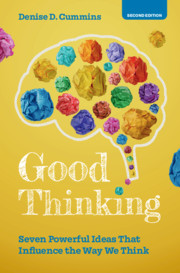Book contents
- Good Thinking
- Good Thinking
- Copyright page
- Dedication
- Contents
- Figures
- Tables
- Preface
- Part I
- One The Game of Logic – What Follows from What
- Two Moral Judgment – How We Tell Right from Wrong
- Three Analogical Reasoning – The Heart and Soul of Insight, Discovery, and Genius
- Four Scientific Reasoning – Proving What Causes What
- Five Decision-Making – Choosing What Is Most Likely to Give You What You Most Want
- Six Game Theory – When You’re Not the Only One Choosing
- Seven Creative Problem-Solving – Turning What You Don’t Want into What You Do Want
- Part II
- Appendix A Answers to Insight Problems
- Answer Key to Quizzes
- Notes
- Index
Four - Scientific Reasoning – Proving What Causes What
from Part I
Published online by Cambridge University Press: 18 February 2021
- Good Thinking
- Good Thinking
- Copyright page
- Dedication
- Contents
- Figures
- Tables
- Preface
- Part I
- One The Game of Logic – What Follows from What
- Two Moral Judgment – How We Tell Right from Wrong
- Three Analogical Reasoning – The Heart and Soul of Insight, Discovery, and Genius
- Four Scientific Reasoning – Proving What Causes What
- Five Decision-Making – Choosing What Is Most Likely to Give You What You Most Want
- Six Game Theory – When You’re Not the Only One Choosing
- Seven Creative Problem-Solving – Turning What You Don’t Want into What You Do Want
- Part II
- Appendix A Answers to Insight Problems
- Answer Key to Quizzes
- Notes
- Index
Summary
According to the National Institutes of Mental Health, major depression is one of the most common mental disorders in the United States, affecting over seventeen million Americans. This is a serious public health issue because depression can severely impair a person’s ability to carry out major life activities. The prevalence of depression is nearly twice as high in females as it is in males, and the rate of depression is highest among young people aged 18–25. An estimated 65 percent of people who have been diagnosed with depression are treated with a combination of psychotherapy and medication, with mixed success (www.nimh.nih.gov).
Dr. X has noticed that patients in his practice who are depressed also have lower levels of a certain chemical in their blood. He develops a product that raises the level of that chemical, and sure enough his patients claim they feel much better. On the basis of this, he writes a book touting the importance of boosting levels of that chemical, goes on talk shows, and launches a self-help website in which he offers his product for sale.
- Type
- Chapter
- Information
- Good ThinkingSeven Powerful Ideas That Influence the Way We Think, pp. 62 - 88Publisher: Cambridge University PressPrint publication year: 2021



